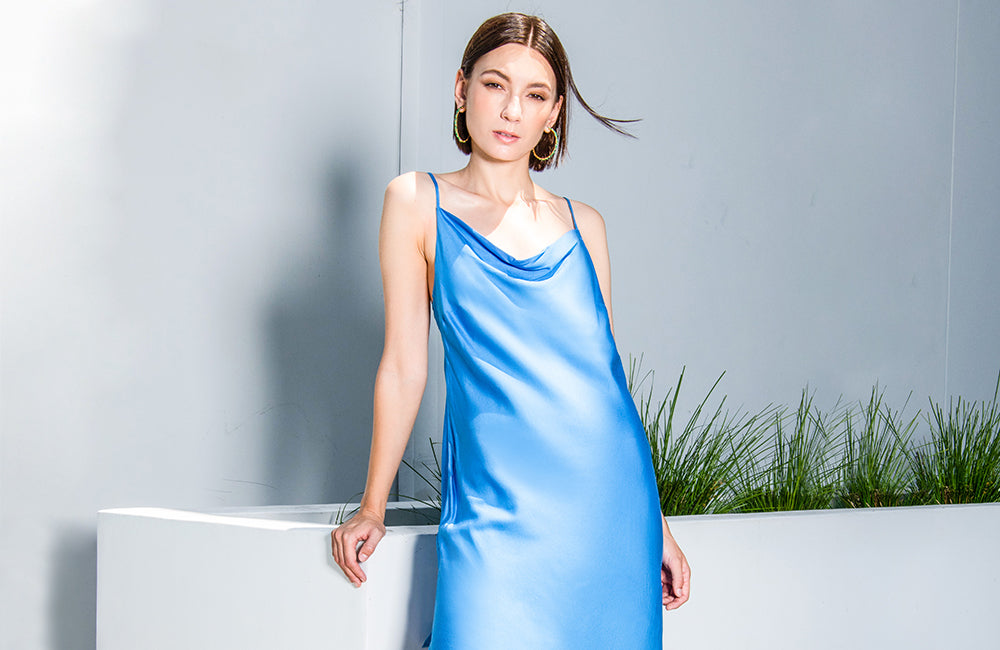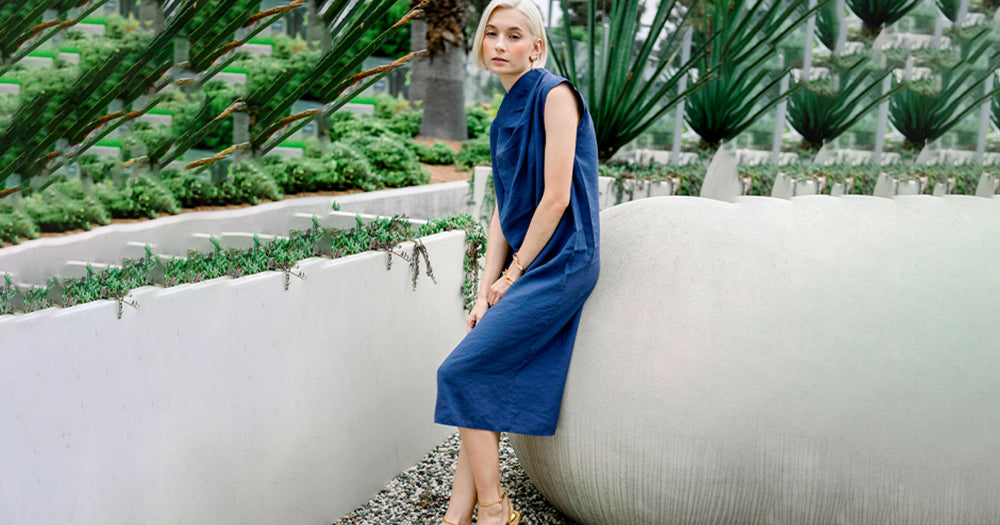Size Chart


When it comes to buying sustainably, it’s tricky to separate fact from fiction.
There are hundreds of brands out there shouting about sustainability. Yet, when it comes down to it, many of those ‘sustainable’ brands simply slap a recycled paper label on a polyester dress and call it a day. It’s hard to cut through the noise and hunt down those options that really do make a difference to life on our green planet.
So, if you’re looking to invest in a sustainable dress, how can you buy correctly? What factors should you consider while you’re on your hunt for your next sustainable purchase?
As a team who lives and breathes sustainable fashion, we’ve found we’re in a uniquely privileged place to recognize what makes a brand worthy of a sustainable credential. Read on for our top six factors to consider when you buy your next sustainable dress.

First up, though, let’s remind ourselves of why sustainability should always be the aim.
The environmental harm caused by fast fashion is undeniable. You don’t need to look hard to find toxic dye spills, lakes running dry, and local communities damaged by the fashion landfill. The exponential increase in global fashion consumption, fueled by the proliferation of ruthless "fast fashion" brands, is creating an environmental catastrophe.
We’ve got to act.
The good news is that brands are starting to wake up. Now, 1 in 4 of us are starting to look at sustainable credentials before we make a purchase, and fashion retailers are taking note. Plus, buying sustainably is better for our wallets, too. A sustainable fashion piece lasts longer, is made with more durable and versatile materials and (we might be biased here!) looks and feels better as well. Buying sustainably is always worth it, for ourselves and for our planet.
So, how to select a green fashion brand that’s worthy of your attention? Here are our 6 sustainability factors to consider, and why they’re important.

Our number one tip, and usually the easiest step to practice, is to select your new dress in sustainable materials.
Plant-based fibers, such as linen and silk, have long been considered sustainable options due to their biodegradability and low environmental impact. Another material we’ve fallen in love with is TENCEL™, a fabric made from sustainably sourced wood pulp. It boasts a closed-loop production process that minimizes waste and energy consumption and feels deliciously soft on your skin.
Watch out for polyester. Despite its ubiquity, polyester is harmful for our bodies and the planet. It never decays, instead is simply broken down into micro-plastics which permeate every part of the planet. Your cheap, stretchy gym leggings? Plastic-based garments like those can shed up to 17 million microplastics with every wash. If you can choose something else, you should.
It’s okay to wear the same item twice, you know.
Sustainable fashion is not only about the materials used but also about the longevity of the pieces you buy. Choosing versatile dresses that can be worn multiple times is a quick way to reduce your spend and buy sustainably.

Our recommendation is to buy shapes that fit in many places. Our Bias Cut Slip Dress, for instance, can be styled on the beach, under a blazer at work, with a chunky knit and tights as the winter draws in, or even in Snow White on your wedding day — why not?!

Sustainability in fashion goes all the way across the supply chain. From the manufacturing process to the final product, true sustainable fashion brands take care to improve at every step.
Unfortunately, the most frequently used fashion manufacturing processes can be harmful to both the environment and the workers involved. As polyester piles up, microplastics flood our waterways and harmful chemicals leave their impacts on textile workers’ bodies, it’s critical to research how your favorite brands make their clothes, and what they’re doing to leave a healthier planet behind.
This factor is hard to see as a consumer, but the biggest indicator of sustainability in manufacturing is visibility. Does that brand make it clear where their factories are located? Can you see who is making their dresses? If it’s all hush hush, that’s a red flag.
It’s true that fast fashion has trained us to consume clothing quickly and dispose of it just as fast. We’re all guilty of buying that too-tight dress because it was on sale, just to have it sat in our closet for years, labels still on.
Buying clothes that fit and that have room to grow is a great step in reducing our clothing waste. Find true-to-size brands that provide you with room to breathe. Buy a sustainable dress with adjustable straps, or with a length that works for the day and the night. Choose a dress that hand-ties at the waist, to let in or out as your body changes.
High-quality, sustainable dresses are made with durable materials and are crafted with care. True sustainability can withstand wear and tear and will last for years, even as our bodies change and grow older.

Okay, we confess, this one is a little controversial, but it is certainly something to be considered.
Vegan fashion products are free from animal-derived materials, such as leather, fur, and wool, which can have a significant environmental impact. With some estimates putting beef (of which leather is a by-product) as responsible for a huge 18% of global methane emissions, it’s critical that we reduce our consumption and select plant-based where we can.
Yet the term vegan doesn’t immediately give the green light to a fashion brand. Some animal products can be sustainable if managed correctly. Our eco-cashmere is a great example of this. We source the wool from local goats in Mongolia and produce it in a cooperative in Kathmandu, Nepal. The goat farming is a great way to support indigenous people, and we ensure that the cashmere is produced in small batches to retain its quality and sustainability.
Ultimately, while we should strive for plant-based dresses that align with our live-kindly values, we should consider the whole product when evaluating sustainability. The label "vegan" can be used for greenwashing, masking poor manufacturing processes and the use of plastic-based materials.
Finally, and most importantly, a sustainable dress brand will always consider the wider social implications of their business, and take steps to leave a positive footprint.
The fashion industry has a significant social impact, and it is crucial to make conscious choices that support communities with fair wages, benefits, and safe working environments. Many garment workers, especially in developing countries, work in hazardous conditions with long hours and low pay.
Yet how can we see this when it’s often hidden so well? Sustainable fashion brands often work directly with manufacturers and factories to ensure that their workers are paid fair wages, have access to benefits, and work in safe and healthy environments. They prioritize transparency in their supply chain, allowing consumers to track the journey of their clothes from production to sale.
One more tip for recognizing a sustainable dress brand with ethical practices is to look for certifications such as Fair Trade or GOTS (Global Organic Textile Standard), which ensure that workers are treated fairly and work under safe and healthy conditions. If it’s got these, then you’re good to go!

Sustainability is our ethos at Neu Nomads, and we’re driven to leave the fashion industry in a better place than when we came to it. We’re done with greenwashing fads and fake sustainable ads. This earth is our home, and we’re going to protect it.
In our affordable sustainable dresses range, you’ll see every factor above has been carefully considered. For our dresses, we work with plant-based TENCEL™ which provides a luxury, elevated, silky feel that’s as easy on your skin as it is on the planet.
We’re so committed to versatile style that this upcoming season only sees one neu design, while our other designs get a whole new splash of color. We specifically design our items to be timeless, so the usual passing of seasons and trends doesn’t affect us like it does other fashion brands. Plus, our designs are meant to grow with you – they’ll be there for you on your honeymoon, at that important meeting, and in your day-to-day casual too.
Most importantly, we make everything visible. You can meet our garment workers right now, on our website. You can see where everything comes from and how it makes its way to you. We’ve got everything considered when it comes to sustainable dresses, so you can feel confident in a purchase that doesn’t just look great, it does great too.

Fast fashion has been the standard for decades, with speed and cost coming before ethics and quality. But for ethical consumers, ethics and sustainability are not negotiable. Moral fashion isn’t about a trend — it’s a transition to a more sustainable, longer-term mentality on clothing.

Fashion is changing, and sustainability isn’t just a trend — it’s the future. The Future of Sustainability is Today.

A minimalist wardrobe is more than just a style; it is a lifestyle choice, one that is centered on sustainability, flexibility, and intentionality. “The careful building of a wardrobe of classic, high-quality items allows you to simplify the everyday problem of dressing, keep clothing out of landfills, and be more intentional in your shopping.